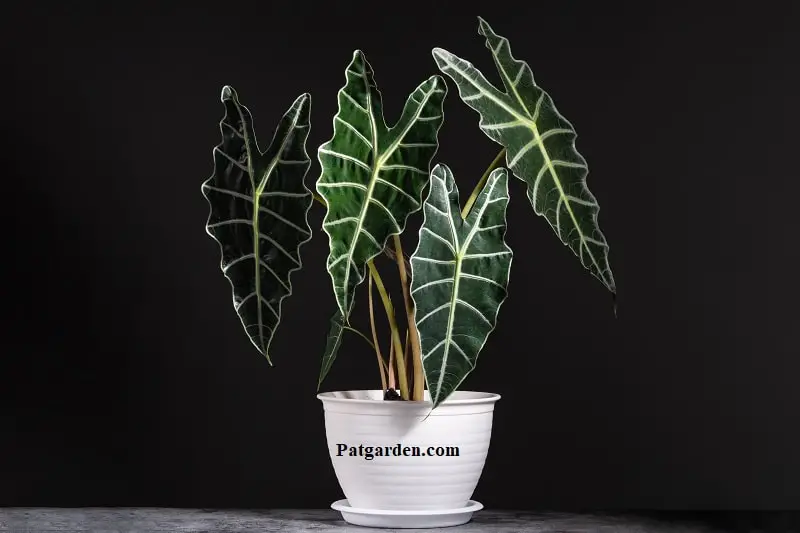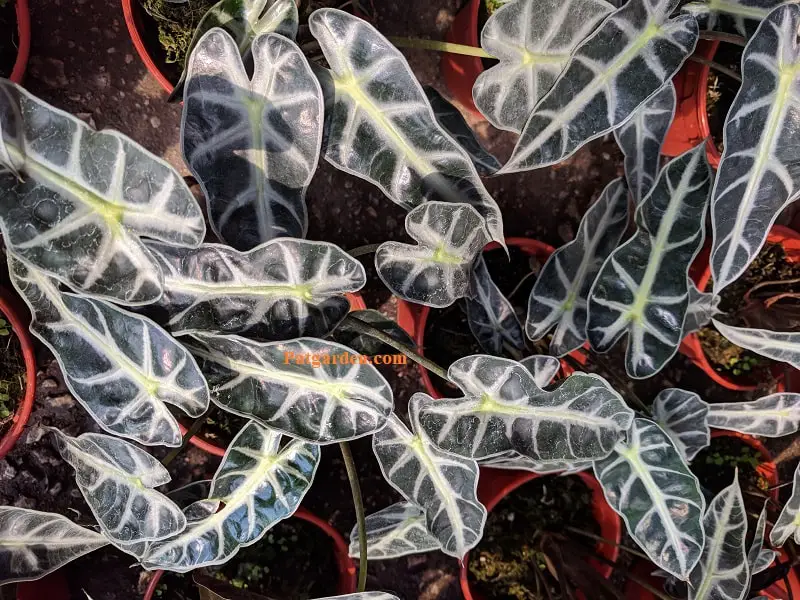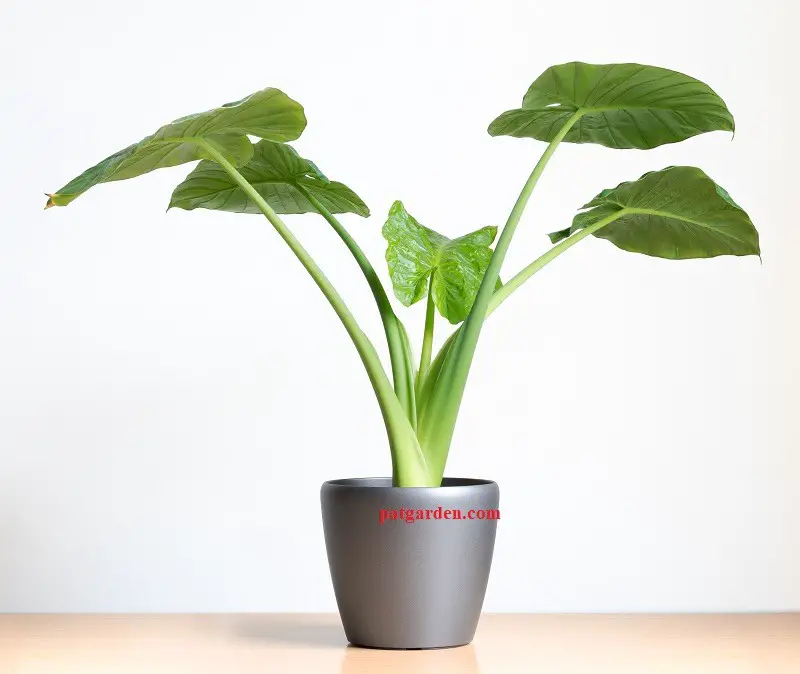The Alocasia Zebrina (elephant ear) has unique leaves that help to bring an amazing appearance to your indoor space. The houseplant is quite aggressive and rarely experiences any problem.
Alocasia zebrina leaves drooping is the number one problem affecting the indoor plant. The good news is that the elephant ear leaves drooping can be fixed and prevented from occurring.
So, why is my Alocasia zebrina drooping? Droopy leaves could be due to water stress, improper light, nutrients deficiency, low humidity, temperature stress, and dormancy. Fixing the issue will help to restore your houseplant.
The article provides a detailed explanation for alocasia leaves drooping causes and methods of correcting the problem. Take the time to read through the information for more insights.
You May Also Like: Why Are My Alocasia Leaves Curling?

Causes and Solutions for Alocasia Zebrina Leaves Drooping
Improper Light
Lighting is a crucial element that spearheads good health for any indoor plant. It enables the houseplant to undertake photosynthesis that facilitates good growth.
Alocasia zebrina thrives under bright indirect sunlight. The filtered light allows the elephant ear plant to experience ultimate growth.
But low light makes the indoor plant have stunted growth and increases the risk of overwatering due to reducing water requirements.
Too much light exposure increases the rate of transpiration and evaporation. Thus, the rate of water intake becomes lower than the rate of water loss.
The elephant ear plant will end up having droopy leaves in the long run. Watering the plant and changing the location will restore the normal status.
Place the houseplant pot far away from the region with too much light. It will help to prevent the leaves from scorching and drooping.
You May Also Enjoy: Why Does My Yucca Cane Plant Have Yellow Leaves?
Low Humidity
Elephant ear plants flourish in areas that have high humidity. Replicating the condition in our homes can be quite difficult for some growers.
Alocasia is one of the houseplants that cannot tolerate arid conditions. The environment makes the indoor plant to lose a lot of water compared to the amount of intake.
Elephant ear plant with droopy leaves is an early sign of low humidity. It can also come along with curling leaves, brown leaf tips an edge.
The houseplant has delicate leaves that need sufficient water to maintain an upright posture. The inability of the root system to increase the intake of water facilitates the occurrence of droopy leaves.
Purchase a digital hygrometer and thermometer to help in monitoring the humidity of alocasia. The instrument will let you know when the humidity is too high, moderate, and low.

Pests and Diseases
Alocasia is highly susceptible to pests and diseases. These are some of the popular conditions that contribute to the yellowing and drooping of leaves.
Some of the common pests that attack alocasia leaves are spider mites, mealybugs, aphids, scale, and thrips. These creatures suck the leave and stem sap that makes the plant droopy.
Regular inspection of the leaves and stems for any signs of pests is quite important. Use an insecticide to kill the pests and restore your houseplant.
Root rot is another common disease that causes alocasia to become droopy. The fungal disease inhibits the intake of water and other essential nutrients.
The rate of plant transpiration becomes higher than the rate of water absorption. The elephant ear plant begins to droop leaves and wilt in case corrective measures are not implemented.
Repot the plant to another container with a bigger space. Cut off the roots that are infected to avoid spreading the fungal disease after transplanting.
You Can Also Read: How to Care for Alocasia Dragon Scale Plant
Plant Dormancy
Alocasia zebrina plants do experience dormancy at some point in their lifetime. It is a natural cycle where the plant experiences a period of overgrowth, dieback, and followed dormancy.
There is no need to freak. The situation is quite normal and natural. The plant will regain its natural growth at the end of the day.
Keep in mind that plant dormancy is enhanced by low light and temperature. It implies that dormancy in the alocasia plant happens in winter.
Elephant ear plants exposed to sufficient light and the appropriate temperature are likely not to enter the stage of dormancy regardless of the season.
Reduce the number of watering when the plant is about to enter the dormancy stage. Ensure the alocasia zebrina plant gets moderate light and temperature until the new growth emerges.
It is also good to note that dormancy lasts for weeks or six months. Do not try to implement other measures once you have identified the cause of drooping leaves is dormancy.
You May Also Enjoy: Why Are My Alocasia Leaves Turning Brown?
Overwatering
A lot of growers’ associate leaves drooping with under-watering. But overwatering usually cause many problems to the elephant ear plant.
Overwatering makes the potting soil soggy and waterlogged. These conditions reduce the level of air circulation in the soil which affects the well-being of the root system.
The inability of the roots to receive an adequate supply of fresh air causes death and even emergency of root infections.
The infection makes the roots unable to absorb essential nutrients and water. Hence, the reason behind the alocasia leaves drooping and dying.
Get a pot with drainage holes and filled it with well-drain soil. Repot the houseplant and stick to the watering schedule to minimize the risk of overwatering. Check the level of moisture in the soil before commencing watering.
Under-Watering
Alocasia plant thrives in an area that receives moderate water. It helps to create an environment that is similar to its natural habitat.
Limping and drooping leaves are the first indicators of underwatering. The plant tends to lose a lot of water compared to the amount of intake.
The good news is that fixing alocasia droopy leaves due to under-watering is quite easy. Place the plant in a region where there is moderate light and water the plant.
Remember to check the moisture level in the soil to confirm if it is due watering issue. It will help to rule out other possible causes of alocasia zebrina drooping.
You Can Also Like: Why Is My Alocasia Polly Dying?
In Conclusion

The main causes of alocasia zebrina drooping are overwatering, under-watering, and low humidity. These are the crucial issues to investigate before considering other possible causes of elephant ear plant leaves drooping and dying.
The most incredible thing is that all these issues can be fixed. Take time to read our article and take note of every solution highlighted. We hope you found this information helpful.
You Can Also Read: How to Care for Begonia Maculata
